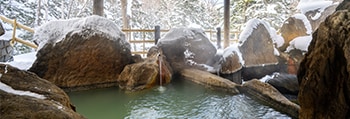One of the must-see places when you visit Noboribetsu is the Noboribetsu Date Jidai Village, a historical theme park that recreates a town from the Edo Period (1603-1867), particularly when the Tokugawa Shogunate ruled Japan and ninjas and samurai were active — hence its nickname “Ninja Village.” The Daishinto Corporation built it in 1992 as a chain of theme parks, like the Nikko Edomura.
Once you enter the village, you are transported back to yesteryears — with merchant streets featuring restaurants, sweet stalls, souvenir shops, samurai residences, ninja houses, and more.
Date Jidaimura features reconstructed buildings from the Edo Period, allowing visitors to experience the lifestyle during the time. Aside from enjoying a tour around the town, looking at the unique façade, and taking lots of photos, you can also enjoy live shows, such as ninja battles outside a house and Oiran (courtesan) performances. These shows recreate the types of entertainment the wealthier people must have enjoyed during the Edo Period. Some performances are seasonal — such as outdoor action shows and Nyanmage comedy in the summer, and samurai shows in the winter. Nyanmage comedy is a performance featuring a samurai cat mascot character.
Visitors can rent costumes and roam around the village, taking photos and making fun memories. There are also ninja costumes available for children. You can explore a Ninja maze and even try your hand at shuriken throwing. A shuriken is a concealed Japanese weapon used by samurai or ninja.
The park also includes a fire watchtower, a shrine, a Matsugaike pond, and the Katakura Kojuro House — a restored mansion that recreates the residence of Katakura Kojuro, a military strategist for Date Masamune’s army. The house gives visitors a glimpse into the life of a samurai commander during the Sengoku period. Inside the Katakura Residence, you can observe the skills of katana craftsmen and learn how the swords were made. There is also a ninja museum featuring the history and code of the secretive ninja. Outside, you’ll see an elegant Japanese garden.
Date Jidaimura also houses the Onyanko Temple and the Yokai Bikkuri Hut. Onyanko Temple is a unique attraction with a cat theme. It invites you to explore a world of cats that you’ve never seen before. But despite its cute and welcoming exterior, it’s actually a ghost temple that can be a little scary.
The Yokai Bikkuri Hut is a spooky house filled with traditional Japanese yokai (a class of monsters unique to Japanese folklore) and other creatures. Inside the house, you’ll see featured dolls and other intricately crafted pieces. You’ll also find maps that show where yokai have been spotted in the surrounding landscape.
In the merchant quarter, you can also sample various delicacies, such as Mitsukuni Ramen and Daidango. Before you leave, stop by Shichimangoku and Fukutoku-ya for some limited-edition souvenirs to take home as memorabilia for your trip.
Address: 53-1 Nakanoboribetsu-cho, Noboribetsu City, Hokkaido Prefecture 059-0463, Japan
Opening hours: 9:00 AM to 5:00 PM in the summer, 9:00 AM to 4:00 PM in the winter
How to get to Date Jidaimura: From New Chitose Airport, take the Rapid Airport Line to Minami-Chitose Station. Transfer to the Hokuto Line and get off at Noboribetsu Station. From there, it’s a 6-minute bus ride on the Donan Bus to get to the village.




















Share
SHARE